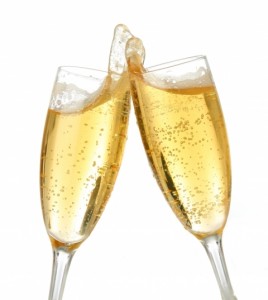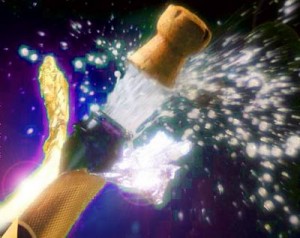
As much a part of New Year’s Eve celebrations as singing “Auld Lang Syne,” watching the ball drop and kissing that special someone at the stroke of midnight, popping open a bottle of bubbly and toasting the new year with a glass of champagne is a long-recognized New Year’s tradition.
In fact, champagne is THE celebratory drink and beverage of choice for many festivities. And, while you may just think it’s the bubbles that have made this a drink automatically associated with celebrations, have you ever wondered why this sparkling wine has become the standard in elegance, opulence and festivities?
While many people associate any sparkling wine with the name “champagne,” true champagne is exclusively made in the Champagne region of France where it originated. Wineries in other parts of the world make the bubbly wine, of course, but France protected the name “champagne” through international treaty and national law, and most countries limit the use of the term to only those wines that come from the Champagne appellation (not sure what an appellation is? Read my Guide to French Wines).
Envious of the stellar reputation of the Burgundy wines from the south, the Champenois (i.e., people from Champagne) sought to produce wines of equal acclaim. However, the northern climate of the region meant the Champenois faced challenges in making red wine—the grapes really couldn’t ripen fully, had way too much acidity and low sugar levels. Blech! But these inhospitable conditions also proved to be the reason that sparkling wines succeeded.
Contrary to popular belief and legend, Dom Perignon did not invent sparkling wine. In fact, in 1662 (6 years before Dom Perignon arrived at the monastery where his sparkling wine was produced), an English scientist wrote a treatise on the “méthode champenoise” (“the champagne method”), which detailed how the addition of sugar in a second fermentation process created bubbles.
So although French monk Dom Perignon did not literally invent champagne, he did come up with the idea of holding the cork in place with a wire so it wouldn’t pop out during fermentation. But it was not until the early nineteenth century that the country saw an explosive growth in champagne production, going from a regional production of 300,000 bottles a year in 1800 to 20 million bottles in 1850. Drink up!
Champagne itself has changed since it was invented, too. In the 1800s champagne was much sweeter than what we drink today. The trend toward drier champagne began when Perrier-Jouet decided not to sweeten his 1846 vintage and created Brut champagne, the modern champagne, for the British in 1876, which is the most popular and widely drunken variety today.

Champagne first gained international attention for its association with the crowning of French kings in Reims (in the Champagne region of France), and champagne wine was served as part of coronation festivities.
At a time when France was one of the dominant world powers and a major cultural force throughout Europe, news about the bubbly wine from the Champagne region of France quickly spread and the drink became wildly popular. And because French nobility represented the epitome of power, luxury and class, champagne automatically was associated with luxury and power. Seizing on this opportunity, the leading manufacturers of champagne devoted considerable energy to creating a history and identity for their wine–associating it, and themselves, with nobility, royalty, luxury and power.
The strategy paid off. Today, champagne has become synonymous with celebrations, luxury and opulence. Cheers!